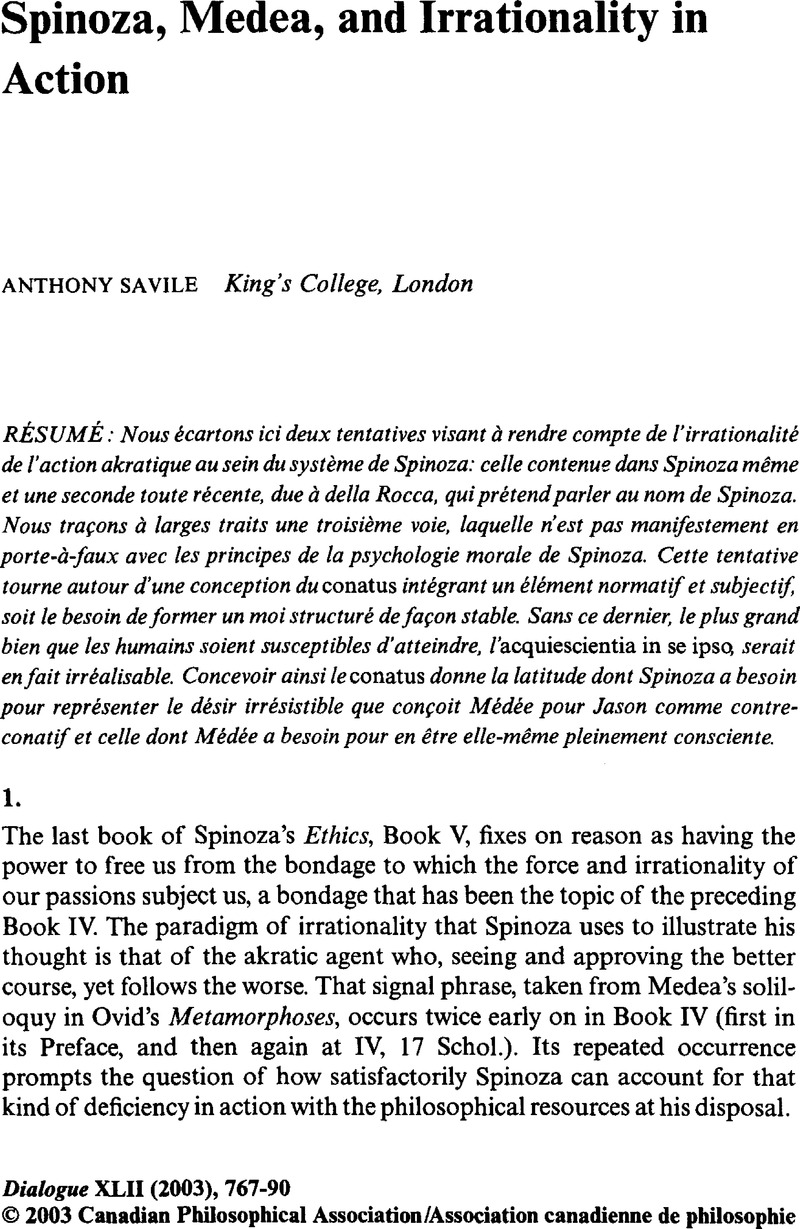No CrossRef data available.
Published online by Cambridge University Press: 13 April 2010

1 In Corneille's version of the tale, Jason expresses his dilemma thus:
Qu'eussé-je fait, Pollux, en cette extremité
Qui commettoit ma vie avec ma loyauté?
Car, sans doute, à quitter l'utile pour l'honnête,
La paix alloit se faire aux dépens de ma tête;
Le mépris insolent des offres d'un grand roi
Aux mains d'un ennemi livroit Médée et moi.
Je léeusse fait pourtant, si je n'eusse été père:
L'amour des mes enfants m'a fait l'âme légère:
Ma perte étoit la leur; et cet hymen nouveau
Avec Médée et moi les tire du tombeau:
Eux seuls m'ont fait résoudre, et la paix s'est conclue. (Médée, Act I, sc. i)
2 Rocca, Michael della, “Spinoza's Metaphysical Psychology,” in The Cambridge Companion to Spinoza, edited by Garrett, Don (New York: Cambridge University Press, 1996), pp. 167–258.Google Scholar
3 Of these principles della Rocca discusses only the conatus in any detail, where it is refined considerably beyond my crude presentation. The more subtle reading of it that he offers does not significantly affect my criticism of his handling of Spinoza's conception of irrationality, so, in offering my own alternative, I ignore it.
4 Della Rocca uses III, 37 Dem. in support: “[A]ll the conatus of a man affected by sadness strives for is to remove sadness.” But this leaves open the idea that the conatus of a man who is not affected by sadness or pleasure may strive to acquire a future pleasure, by acting prudentially if need be. III, 19 explicitly suggests that we seek to think of what increases our power of activity. See also III, 12.
5 It may smooth the move away from della Rocca's interpretation of Spinoza's principles to remember that the present often spans far more than the present moment. The present month is April, and that extends well beyond this particular minute of its eighth day. The word “immediate” too often picks out a close-by future moment in what we think of as the present time, this year or this semester. For the general point, see Westphal, Jonathan, “The Retrenchability of the Present,” Analysis, 62, 1 (2002): 4–10.CrossRefGoogle Scholar
6 Of course, other things may cloud my anticipation, such as the relative complexity of the means I am deliberating about, but that is to introduce additional elements into the equation. They do not bear on the main point.
7 Textually, Spinoza's rejection of future-directed striving is derived from (a) the fact that anticipations of future goods and ills necessarily generate present pleasures or pains of anticipation (as asserted at III, 18, notably at Schol. 2), and (b) the claim at III, 37 Dem., that “all a man affected by sadness strives for is to remove sadness.” The considerations above concerning anticipation and the identification of future states as goods show that the term “completely” is being asked to bear far more weight than it can comfortably support. It is notable that both IV, 9 Coroll. and IV, 60 Schol. seem to envisage desires stemming from joy or sadness that relate to the future having motivational force, though certainly less marked than the force of those that relate to affects that are present.
8 As happened in 1960, when the Paris standard gave way to a definition in terms of the distance travelled by light in vacuum in 1/299,792,458 second.
9 The precepts of Leviticus 19 and 20 exemplify the sort of thing Spinoza will have had in mind to oppose. Consider for instance 19: 35–37: “Ye shall do no unrighteousness in judgment, in meteyard, in weight, or in measure. Just balances, just weights and a just ephah, and a just hin, shall ye have: I am the Lord your God, which brought you out of Egypt. Therefore shall ye observe all my statutes, and all my judgments, and do them: I am the Lord.”
10 It is important to realize that, as Spinoza himself makes clear with his example of the fourth proportional at the end of II, 40 Schol. 2, the same item of knowledge can be assigned to any of the three grades. Eveything hinges on what holds it in place, not its propositional content.
11 The talking therapy can be seen as an entirely natural process by Spinoza's lights. It could even be expected to make its effects felt in the mind through those changes in the body that the talking slowly brings about. (Cf. II, 13ff.)
12 The Preface to Book III asserts that the same laws apply everywhere, not that the same laws apply to everything. The crucial sentence is: “[T]he laws and rules of Nature according to which all things happen and change from one form to another are everywhere and always the same.”
13 Spinoza's reader may be puzzled as to why he should take those, scarcely intuitive, definitions and axioms on board in the first place, and complain that no matter how frictionless the intellectual helter-skelter, the derived theorems will have no greater empire over his mind than those initial elements themselves. Spinoza may counter this protest by saying that the way in which the whole developed system succeeds in throwing explanatory light over our understanding of the world and of ourselves confirms the correctness of those original assumptions, and should fix them intuitively for us after the Ethics has been worked through. If they do not carry conviction at a first reading, a second or third reading may be expected to have that effect.